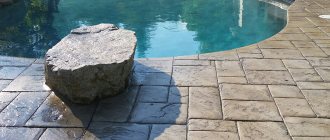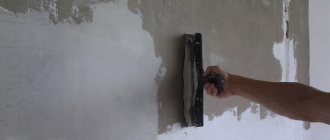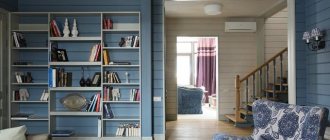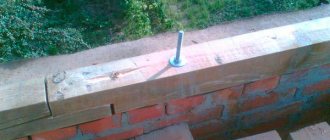Ceramic tiles are the most common covering for walls and floors in a bathroom, toilet or kitchen. It's all about its strength, durability, ability to resist moisture and elevated temperatures - the tile is not afraid of anything and can serve for decades without losing its appearance. But when an apartment is being renovated, you often want to completely change the color scheme of the interior. And this can be done without even removing the tile and replacing it with a new one. How to paint tiles on the floor?
How to paint tiles on the floor
Can tiles be painted?
Can. This unique, durable, moisture-resistant coating can easily be renewed using just this method. At the same time, the ceramic surface is painted very well - the main thing is to choose the right paint and choose the place where it will be applied.
Is it possible to paint tiles on the floor?
On walls, floors and even ceilings, tiles can be safely updated with a fresh coat of paint - there their contact with water will be minimal, and the paint is unlikely to wear off quickly. But it is not recommended to paint tiles located inside showers directly under your feet or directly above the bathtub. The fact is that the durability of the paint and varnish coating, even the highest quality, directly depends on the intensity of exposure to water. And in the shower and above the bathtub, an environment that is too humid for even the highest quality and most reliable paint. In such places, the coating will quickly begin to peel off and all the work will have to be done again. Conclusion - you can safely paint absolutely any tile if it has moderate contact with water.
Painting tiles on a bathroom wall
With the help of paint, the interior of a kitchen or bathroom can be constantly changed as soon as such a desire arises from the owner of the room. Previously, this was exactly how apartment owners got out of the situation; this method of renovating premises was quite common.
On a note! If high-quality paint was used, and all work was carried out strictly according to the rules, then such a coating can last on the tile for up to 30-50 years.
Categories
The anti-slip facing material is marked “Grip” on the packaging, which allows you to identify and highlight it when choosing.
At the same time, the entire range of non-slip floor tiles is divided into 3 categories:
- Mosaic – products up to 100 mm in size. When laying it, a large amount of grout is used, which increases the coefficient of adhesion of the foot (with or without shoes) to the floor.
- Standard - tiles with dimensions not exceeding 300x300 mm. In addition to roughness, on such products they can create three-dimensional patterns, imitating a pebble or grainy surface.
- Porcelain tiles with a matte surface. This type of flooring material is considered the most durable and safe; it can be used for cladding indoors and outdoors (for paving paths or cladding steps).
Porcelain anti-slip tiles can be very small (150x250 mm) and quite large (600x1200 mm).
Why paint tiles?
Many people wonder why even take on this labor-intensive job and paint the tiles? It's actually simple. As mentioned above, ceramic surfaces were previously updated using this method, because previously interesting building materials on the market were not as abundant as they are now. And it’s cheaper to simply paint the tiles than to completely dismantle them and glue new ones. It is worth agreeing that much less labor will be required to paint the tiles than to remove the old ceramic coating.
Painting ceramic tiles
The relevance of this method has not disappeared to this day. Sometimes there is neither time nor extra money to completely replace the tiles, and then paint comes to the rescue. Moreover, now there are very high quality and reliable paint coatings, even waterproof, which are perfect for quickly and at minimal cost completely changing the color of the tile. This is especially true for young families who have just bought an apartment. There is not much money in the family budget, but you need to move into a new home now. And the best assistant in updating the interior is paint.
Conditions under which surface varnishing is unacceptable
In some cases, it is not recommended to apply varnish to ceramic tiles:
- If the tile adhesive has not hardened enough. It takes at least one month for the glue to dry. To speed up the process, it is recommended to lay the tiles with cement adhesive, which will reduce the waiting time.
- If the surface is poorly insulated from moisture penetration, applying paints and varnishes is also not recommended.
Summarizing the above, we can say with confidence that varnishing ceramic floor tiles is a way to renew them and extend their service life.
But for this you need to choose a varnish suitable for ceramic surfaces. The technology for applying varnish is simple - even a non-professional can handle it. Average score of ratings is more than 0
Share link
Comments There are no comments yet, but you could be the first...
What paint should I paint the tiles with?
Different paints can be used to paint tiles. And in order to better understand which one to choose, you should familiarize yourself with the different types of paints and varnishes used for finishing in modern renovations.
Choosing paint for tiles
Table. Types of paints used for painting work.
| Type of paint | a brief description of |
| Water-dispersed | These paints are among the cheapest and most unstable to external influences. They are also called “water-soluble”, “water-emulsion”. The thing is that the best solvent for them is ordinary water. Such paints are not used in bathrooms, kitchens and restrooms, as the coating will quickly wear out and lose its appearance under the influence of high air humidity and temperature changes. The only advantage of such paints is that they do not emit an unpleasant odor during application and dry quickly. There are paints based on PVA, acrylic and latex. |
| Silicone | The paint is made on the basis of silicone resins. It entered the market relatively recently, but has already won the love of many craftsmen. Such paints have a high level of vapor permeability and are successfully used to decorate building facades. |
| Oily | The paint is created on the basis of artificial or natural oils. The service life of coatings created with this material is maximum, and the paint is not picky in its use. The disadvantages of the material include low vapor permeability and a long drying time, which is why such paint often peels off or the bottom layer underneath it peels off. Paint is rarely used to decorate apartments and private houses. |
| Alkyd | Manufactured on the basis of alkyd resins. It dries far differently than usual - not due to the rapid evaporation of the solvent in it, but due to the oxidation reaction of the material in air. Thanks to this, the surface layer of paint is very durable and capable of protecting the processed materials from corrosion. |
| Decorative | This is a separate category of paints designed to give surfaces a special look. Such paint can imitate various other materials - wood, fabric, stone, etc. Decorative paints can be made based on water with the addition of various polymers and minerals. |
| Epoxy | It is created on the basis of ordinary epoxy resin, due to which it is a very resistant composition to external influences. This is truly one of the most durable paints currently available on the construction market. It is not afraid of water, does not wear out over a long period of time, and is often used specifically for painting floors in the house. It can even be used in parking lots, in production workshops, and on staircases. |
Different types of paints can be used to paint tiles. For example, water-dispersion paint based on latex performed well in this work. This material is intended for use in damp areas. Oil paints and alkyd paints are also often used.
Paint in cans
On a note! Coatings obtained by working with oil paints will be so durable that they will not even require additional protection of the painted surface - they do not need to be varnished.
To paint walls that are not particularly in contact with water, you can even use acrylic paints, although they are water-soluble. But for decorating and decorating the floor, it is recommended to purchase compounds that are resistant to water and temperatures, otherwise the work will soon have to be redone. Still, there is nothing better for a floor than a well-applied layer of oil paint. The main thing is to let it dry thoroughly before using it.
The simplest tile that can be given any color
Epoxy-based paints also performed well in the process of painting and using painted tiles. Or you can use latex paints to decorate the tiles. In any case, it is important to carefully read the instructions for use on the packaging and make sure that this composition is suitable for application to the floor, and especially to tiles.
On a note! When decorating tiles in the bathroom, you can use paint to give free rein to your imagination and draw patterns. For this purpose, stencils and car paints produced in cylinders are often used. This paint is expensive, but it adheres well to the base even in extreme conditions.
The tiles will need regular cleaning
If you have any doubts about which paint to buy, it is better to opt for special compositions designed for painting tiles or glass. Such paints are available for sale in hardware stores. You can also opt for acrylate-latex paint from Samtex or Tikkurila. A good paint, suitable for painting tiled floor surfaces, should be resistant to abrasion and not afraid of moisture, because wet cleaning has not been canceled.
Varnish selection and step-by-step application instructions
It is easy to make a mistake with the consumption of the varnish mixture - each type of tile has its own porosity indicator. The absorption of the composition will vary; the thicker the varnish, the less it is absorbed.
Helpful advice! The varnish consumption should be indicated on the packaging, but if the tiles have reliefs and chamfers, multiply by 1.5.
It is advisable to buy varnish with a small supply. It’s better to let it remain than to look for 1 can at points of sale until the work process is completed.
Helpful advice! Choose a two-component varnish that has fine ceramic fractions to fill small cracks.
This is an acrylic base containing tiny ceramic chips. Actively absorbent tiles are varnished twice. The paint and varnish mixture must meet the following parameters:
- gives an even coating without sagging or drips, with the effect of filling minor defects and scratches;
- have high abrasion resistance;
- preserves and enhances color without the obsessive yellowness that often occurs with wood varnish;
- does not require pre-treatment of the tile with any mixture, with the exception of a primer from the same manufacturer.
When preparing a room, it is important to remove all foreign objects in advance (they can absorb odors) and thoroughly clean the floor (or wall) before painting. You will need the following working tools:
- a roller with a suitable attachment and a tray suitable for it in width;
- paint brushes of different sizes;
- dry rags and sponges (for cleaning surfaces);
- medium-grain sandpaper (to smooth out uneven areas at joints);
- sufficient quantity of varnish;
- solvent (to remove residues from tools and hands).
It is important to take all safety measures into account when working. Varnishes contain volatile, flammable substances - smoking and the use of an open fire in the room where painting is intended are prohibited. It is necessary to work in a well-ventilated area without drafts. To protect your skin from varnish and your respiratory system from caustic fumes, it is recommended to wear:
- respirator;
- protective glasses;
- work gloves;
- workwear.
What color should I paint the tiles?
The key to comfort in an apartment is a harmonious combination of all interior elements and impeccable finishing. But there is never a guarantee that one or another design option will look as planned. It is recommended to refrain from the desire to paint the tiles in a bright color, because if it does not look very neat after the work is completed, then the emphasis on it will certainly not be needed .
The best option is a gentle neutral color that blends with the walls. If any mistakes are made while painting the tiles, they will be less noticeable in this case.
Floor tile painting process
Sometimes creative individuals and people who love bright accents paint tiles in several colors at once. In this case, it is easiest to apply the paint using templates or stencils to avoid mistakes and to avoid staining the already applied layer.
Important! If several colors are used when painting tiles, they should be in harmony with each other and match the shades with the interior elements. Only then will the pattern look like an original panel, and not like a tacky daub.
To paint large areas, it is recommended to use regular white paint, adding colors to it. This will save money.
Color solutions
The most common color shades are blue and cyan. You can often find white with green and black with red or gold.
We also note that all tiles are presented in collections. Each set contains compositions that have their own direct purpose. For example, background tiles are intended for the walls of a bowl and its bottom. Therefore, upon closer examination, you can notice that the surfaces of the tiles differ.
In addition to the main tiles, the series includes decor, which consists of panels and friezes. The design of decorative elements is as close as possible to the marine theme.
Tools for painting tiles
To paint tiles, as well as to carry out other painting work, you will need certain equipment. The list of necessary items may vary depending on the scale of the repair, but in general may include:
- fine-grained sandpaper necessary for sanding surfaces;
- primer mixture, preferably epoxy based;
- paint rollers;
- brushes of various sizes;
- rags that will be needed to quickly remove paint stains;
- tray or other container for pouring paint;
- solvent to remove paint from tools;
- wide masking tape, which will be needed to protect the edges of objects or objects adjacent to the surface to be painted;
- degreaser (can be useful, although it is not necessary);
- paint and varnish, which will be needed directly to perform the work and protect the finished painted layer.
Painting tool
It is recommended to carry out all work in old unnecessary clothes or a painting suit. It is better to wear rubber gloves on your hands, and you can protect your hair with a scarf or cap.
Manufacturers
Among the domestic manufacturers, the following promising companies should be highlighted: Russian and . Pool tiles from these manufacturers are characterized by low water absorption and frost resistance.
Among the foreign manufacturers, the following companies stand out: Interbau (Germany), Versatile, Ezarri (Spain), Rose, JNJ (China).
Preparing for painting
Work on painting tiles begins with preparing the surface and the room itself. To begin with, it is recommended to clear the room of furniture and interior items that may interfere with the work. It is recommended to cover anything that cannot be removed with plastic wrap to prevent drops of paint from falling onto the surface. While the paint on smooth objects can still be wiped off, the upholstery of the upholstered furniture cannot be saved without dry cleaning.
It is advisable to cover the furniture with film
The surface of the tile itself also needs preparation. If you neglect this stage, the layer of paint and varnish material will quickly begin to peel off and crumble. The surface of the tile is first washed with some cleaning agent. If the tiles are painted in the kitchen, then it is important to remove all grease stains - the paint will not stick to them. You can degrease the surface using a special liquid or use vinegar or an alcohol solution.
Washing ceramic tiles
Then, as soon as the tile is dry, it is carefully sanded with sandpaper - it is necessary to make the surface slightly rough. Only in this case will the paint stick well. If the tiles on the floor are rough in themselves, then you can do without the grinding step.
On a note! Not only the tiles are sanded, but also all the joints between them.
It is also important to inspect all tiles before painting to make sure they are intact. Damaged elements must either be removed and replaced with new ones, or repaired.
Scope of use
Non-slip facing material has a wide range of applications. Most tiles are used indoors or under canopies, but there are also some that are perfect for use in open spaces.
Most often, non-slip ceramic tiles are needed for finishing:
- bathrooms and showers;
- hallways;
- balconies and terraces;
- summer kitchen premises.
Porcelain tiles have found application in cladding:
- hallways, corridors, balconies in apartments and houses;
- adjacent areas, staircases, ramps and patios;
- hospital and sanatorium premises;
- catering establishments;
- retail and utility areas in stores;
- office premises;
- hotel and entertainment complexes.
This type of cladding is also used in other areas (wherever it is necessary to observe increased safety measures or there is an increased risk of injury).
The procedure for painting work
Step 1. The floor is thoroughly washed and sanded if necessary. Preliminary preparation of the base for painting is carried out. The baseboards are covered with masking tape to prevent them from being stained by paint.
First you need to wash the floor
Skirting boards covered with masking tape
Step 2. The surface of the tile is cleaned of grease stains. This is especially true for kitchen areas. The liquid can be applied using a long-handled brush. Sometimes you have to perform the procedure more than once. It is very important to handle all corners well. Next, the floors are washed with clean water and dried well. It is also recommended to apply a layer of primer to the tiles before painting.
Degreasing the tile surface
Step 3. It's time to apply the paint. It should be distributed evenly over the entire surface. For convenience, it is recommended to use a roller with a long handle. The paint is poured into a paint tray - this makes it easier to wet the roller in it. It is recommended to stir the paint well before use. The material is applied in several layers, and the smoother the surface of the tile, the more layers will be required (up to 3-4). The layers are applied in stages, each after the previous one has dried. Coloring begins from the corner farthest from the exit.
Applying paint with a long-handled roller
Painting floor tiles
Step 4. The corners in the room are well processed.
Particular attention should be paid to the corners of the room
Step 5. After the paint has been applied to the surface, it should dry well. About a day is enough for the first layer, then a second layer can be applied. Next, the waiting time until a new coat of paint is applied is about 6-12 hours, depending on the composition used.
Applying paint to tiles
Step 6: After applying the final coat of paint, you must wait at least 72 hours before the floor can be walked on. This period is necessary for all layers of paint to dry thoroughly.
In this example, the tiles are also painted on the walls.
Video - How to paint tiles
Video – Updating old tiles
Prices for Tarkett floor tiles
Tarquette floor tiles
Pool finishing with glass mosaic
Glass tiles have the lowest water absorption rate. This makes it an ideal facing material, but more expensive than clinker. The main component in production is quartz sand, to which various oxides are added to give a certain shade. The vast majority of glass tiles are mosaics. The shape and size of an individual element can be very diverse. But most often you can find sheets measuring 30x30 or 60x60 cm, on which small squares are glued.
Mosaics whose fragments are hexagons have gained great popularity. Such honeycombs look more interesting and unusual. The big advantage of mosaics over tiles is the presence of a flexible mesh base. Although the installation process itself can hardly be called quick and easy, such a solution greatly simplifies the work. In addition, due to the small size of the individual elements, complex radius-shaped surfaces can also be covered with mosaics. It is possible to divide the sheets into smaller pieces and create a colorful, detailed panel on the bottom or walls of the pool. In addition, glass mosaic has the following advantages:
- Long period of operation;
- Heat and frost resistance;
- Immunity to chemical reagents;
- Absolutely smooth surface without pores, which can be breeding grounds for harmful microorganisms;
- Increased impact resistance, which is achieved by additional firing of each individual element;
- Varied and extensive color palette;
- Color fastness to ultraviolet radiation;
When dyes are added to the composition during manufacturing, each individual tile can have its own individual shade, which is most clearly manifested under water. This creates an internal shimmer effect and a stunning optical illusion. The water in the pool begins to shimmer and shimmer.
Where is it used?
The tank floor is lined with the following types:
- mosaic;
- rubber tiles;
- glazed clinker.
For wall decoration use:
- mosaic;
- ceramics;
- tile;
- marble.
To finish the paths near the tank, the following types are used:
- sidewalk;
- rubber;
- ceramics.
Overfill protection
Thanks to this protection, the water circulation in the pool is brought back to normal, and the water that leaves the pool does not flood the surrounding area. Such protection can be installed at the edges of the pool. It looks like hidden grooves.
There are three types of protection: “Finnish Coast”, “Zurich Coast” and “Wiesbaden Coast”.
- The Finnish shore is a surface made at an angle and rising from the wall to the overflow, and the manual grip is made in the form of corrugated tiles. Mainly used in large swimming pool complexes.
- Zurich coast. The gutter is located behind the edge of the structure or adjacent to it. The drain is raised. Can serve as a hand grip. Used in public swimming pools.
- The Wiesbaden coast is high-level. With such protection, the overflow channel is flush with the surface of the water. The thickened edge serves as an overflow and hand grip. Protection is used in all types of pools.
- The Wiesbaden coast is low-level. This type of gutter is placed approximately 25-30 cm below the floor level. The absence of a protective grille near the groove allows swimmers to hold on to it, and the beveled slabs ensure that the waves quickly subside.
How to choose glue?
In order for the facing material to last as long as possible, it is important to pay attention to the choice of glue. It is this that creates reliable waterproofing.
The adhesive must meet the following requirements:
- Elasticity to relieve water tension.
- Resistant to constant exposure to water.
- Resistant to chemicals.
- Antifungal properties.
If the pool is of an open type, then the glue must be frost-resistant. Read more here.
Options in the production market
Before purchasing tiles, it is important to find out about the most popular manufacturers.
Russian
Among domestic manufacturers, the products of the following companies have proven themselves well:
- “Falcon” - its price varies from 650 rubles/m2;
- “Kerama Marazzi” - its price varies from 850 rubles/m2.
Foreign
The most popular products include products from German manufacturers:
- “Interbau blink” - average price in the range of 2500-3000 rubles/m2;
- "Agrob buchtal" - average price in the range of 1800-3000 rubles/m2.
Useful tips
The following tips from experienced professionals will help you complete the pool finishing job correctly.
- To cover the bowl of a reservoir, you should not use large-sized tiles - they can be deformed under the influence of strong pressure from the water mass. Its dimensions should be no more than 12.5 x 24.5 cm.
- Pools in the shape of a rectangle can be tiled with dimensions of 15x15cm. For ponds with a non-standard shape, you will need tiles with smaller dimensions: with a width and length in the range of 2-10 cm.
- for cladding outdoor pools , since they cannot withstand large temperature changes, their chips come off and the mosaic has to be repaired frequently.
- When covering a bowl with mosaics with small elements, it is recommended to first glue them to paper sheets: this will make it easier to transfer the selected elements to the right place. To remove the paper, you need to wet it.
- To cover various structural elements of a reservoir (walls, bottom, stairs), only appropriate tiles should be used. Any tile has a marking that indicates the degree of water absorption, the level of anti-slip and what elements it is intended for cladding.
- It is not recommended to prepare a large amount of glue at once, as after 3 hours it dries out and becomes unusable.
- Dry mixtures should be prepared strictly according to the instructions, without violating any point or proportions, otherwise the glue will not have the required quality.
- Adding liquid glass to glue increases its performance properties. This solution, which is based on sodium and potassium silicates, has a very high degree of penetrating ability. Therefore, it can be used to seal any type of base.
For more information about pool tiles, see the following video.
The best manufacturers
The market for finishing materials is represented by a large assortment of tiles; you can find products from both foreign and Russian manufacturers. The leading domestic tile manufacturer is Kerama Marazzi , which has been on the market for more than 30 years. Italian technologies are used to produce high quality products. The produced tiles comply not only with Russian, but also with international standards.
The products of the following German companies are in constant demand:
- Interbau Blink , which produces up to 40 types of ceramic tiles with non-standard colors;
- Agrob Buchtal , which produces about 70 sets of luxury finishing tiles, the distinctive feature of which is a unique antibacterial coating that prevents the formation and development of bacteria.
The Turkish manufacturer is represented by Serapool, a company that produces porcelain tiles that have international quality certificates.
In addition, the products of such foreign companies are no less popular:
- Floor Gres, Trend, Skalini - Italy,
- Natural Mosaic, Primacolore - China;
- Latina Ceramica, Ceracasa - Spain.











